What is wrong with my chickens comb?

The chickens comb is a fascinating part of the animal. You can tell many things about the chicken by looking at the comb.
Table of Contents
- What is a chickens comb?
- Do all chickens have a comb?
- What colour should a chickens comb be?
- Can a chicken live without a comb?
- What does a healthy comb look like?
- What does an unhealthy chicken comb look like?
- How does the Colour of the comb indicate the health of the chicken?
- What causes black spots on chicken combs?
- Droopy and floppy combs on chickens:
- Blisters, lumps and swellings on the comb:
- How to clean chickens comb:
- Why is the comb dry?
What is a chickens comb?
The comb is a large fleshy growth on the top of the chickens head which is larger in the males than the in the females.
The purpose of a the comb and wattles in chickens is primarily for cooling and display.
Combs are often quite large and have a good blood supply to the surface of the skin, hence their bright red colour. As chickens do not sweat this enables cooling in hot weather.
Both hens and cockerels have a comb and it is always larger in the males than the female. Chickens hatch from the egg with the comb already in place and they begin to develop and turn red around 8 weeks of age for cockerels and 12 weeks of age for hens.
Combs are also used for mate assessment and a full bright comb indicates a healthy bird. Hens' combs darken and swell as they come into lay.
A chickens comb is made up from collagen and flesh and is covered with a slightly modified skin that has a different texture to normal chicken skin. In the past they have been a delicacy particularly in French cooking as a garnish.
Do all chickens have a comb?
All chickens have a comb even though it may be really small in some types.
The 9 types of comb are:
- Single comb,
- Rose comb,
- Walnut comb,
- Pea comb,
- Cushion comb,
- Buttercup comb,
- Strawberry comb,
- V comb,
- Carnation comb.
What colour should a chickens comb be?
A chickens comb should be bright red, except for Silkies which have a plum coloured comb and all black chickens like the Ayam Cemani which have a pure black comb.
Chickens combs are often treated with oils in poultry shows to bring out the bright red colour.
The comb can also help tell the age of the chicken, as the bird ages marks and scars will appear and the tips might get nipped of in fights.
Can a chicken live without a comb?
A chickens can live normal lives without a comb and the comb will never grow back, once it has been damaged or injured it becomes a permanent disfigurement.
In the old days, fighting cocks and chickens with large combs were "dubbed" or had their combs and wattles removed with a pair of sharp scissors.
Below: A Barnevelder cockerel of mine with a piece of his comb missing.
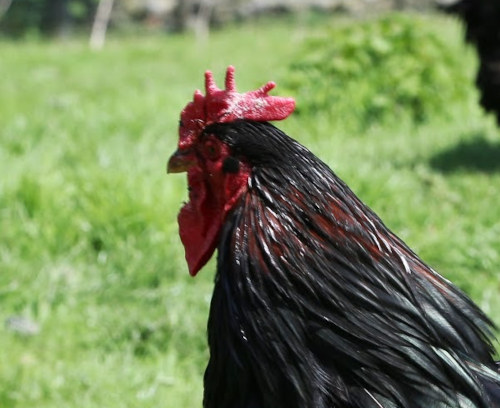
Cockerels can lose chucks of their combs while fighting and recover just fine. In the same way a chicken that has lost part of it's comb to frostbite can go on to live a normal life.
What does a healthy comb look like?
A healthy comb will be firm and rubbery to the touch and a bright even colour with no marks, discolouration
Below: My Light Sussex cockerel with a full healthy comb.
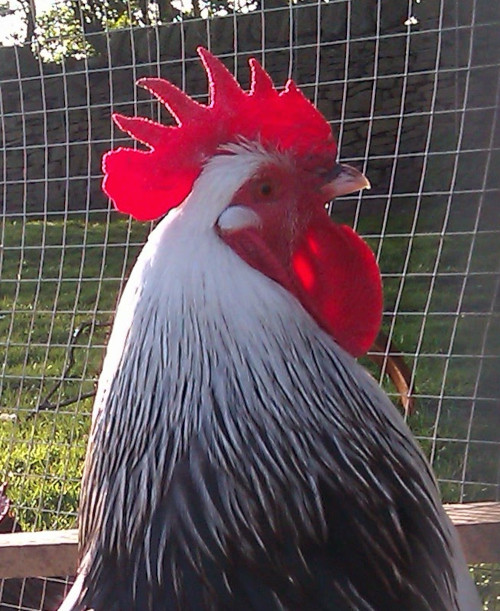
Some breeds do have a large comb that flops over to one side so that is not necessarily an indication that something is wrong.
What does an unhealthy chicken comb look like?
An unhealthy comb will be very pale or discoloured, or have white patches of flaking skin. Black Combs are a sign of frostbite, purple combs are a sign of circulation problems and blistering could be either disease, insect bites or sunburn.
Below: This is the comb of a sick chicken. It is has lost it's firmness and is pale and covered in white flaky skin.
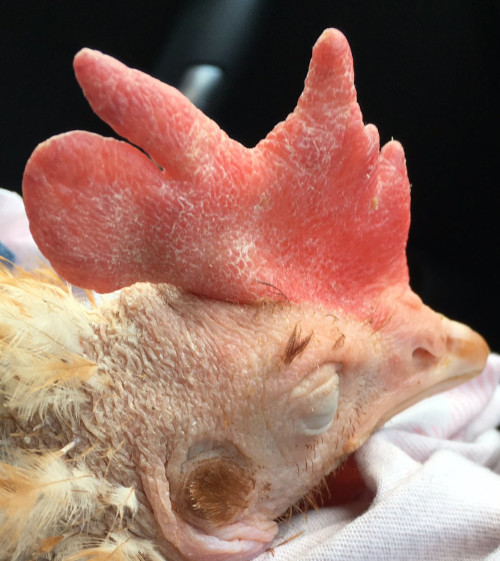
A slightly pale comb on an otherwise healthy chicken may indicate a young bird or a hen that has stopped laying.
How does the Colour of the comb indicate the health of the chicken?
A white comb indicates a chicken that has internal bleeding, anaemia or a heavy parasite infestation.
The white means the blood has stopped flowing to the comb and it can be a sign of impending death.
A pink comb is not normally a symptom that something is wrong unless it is accompanied by swelling, discharge or smell. A pink comb is a sign the hen has not started to lay eggs or has stopped laying for the moult.
Below: This Pekin bantam has a pink comb but is completely healthy.

A black chickens comb is normal for black chickens like the Ayam Cemani. Chickens developing a black comb are likely to be suffering from frostbite. The black parts of the comb will shrivel up and drop off. Chickens are remarkably resilient to injuries of this type.
A comb turning black in summer is probably sun burn if the bird is otherwise healthy.
A black and swollen comb may be the sign of a snake bite.
Below: An extreme case of frostbite on a cockerels comb.

Frostbite can look nasty but the chickens normally recover well as long as they are left alone and not pecked at by other chickens.
Frostbite rarely bleeds, it starts off white, changes rapidly to a yellow and then black and begins to slough away.
A blue comb in chickens is a sign that there is a circulation issue or lung problem, the blue colour comes from the blood not being oxygenated properly.
Below: The comb turning blue on a cockerel. This is called Cyanosis and a sign something serious is wrong.
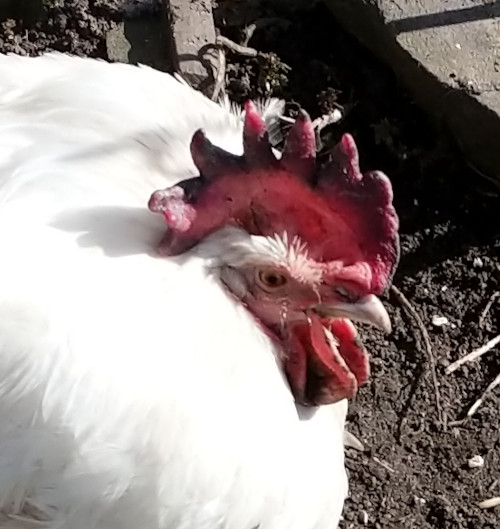
A blue comb in chickens means the bird is getting enough oxygen to survive for long.
A purple comb in chickens is the advanced stage of Cyanosis. It can indicate a problem with the heart, lungs or liver of the bird.
Purple comb at the tips is not normally anything to worry about unless it spreads. This slight discolouration at the comb tips can happen to both hens and cockerels in sunshine in summer and in young cockerels in the prime of their life.
Below: This young cockerel in his prime has comb tips that are deep blur or purple and he is in excellent health.
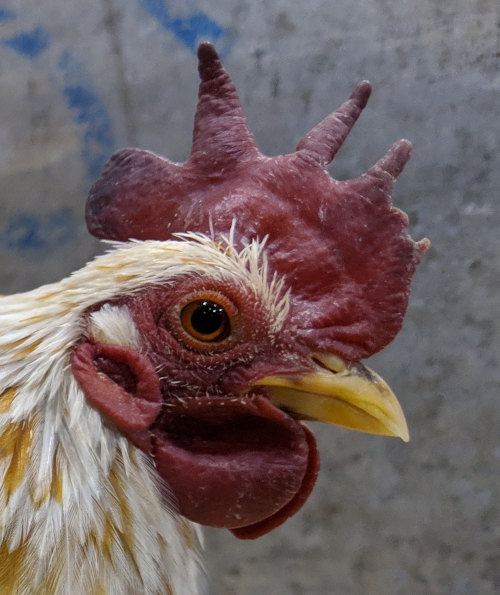
It may also indicate he is a little warm and the blood flow has increased to the comb.
What causes black spots on chicken combs?
A chicken gets black spots on its comb either because of fowl pox, fighting or insect bites.
Below: This is a chicken with fowl pox.
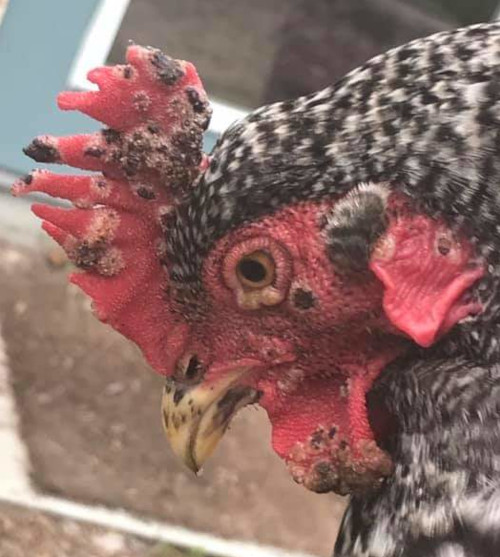
The black scabs from fowl pox are large and raised and will persist for weeks.
Below: The black scabs from insect bites or fighting are very different, they are flat and tend to be much smaller.
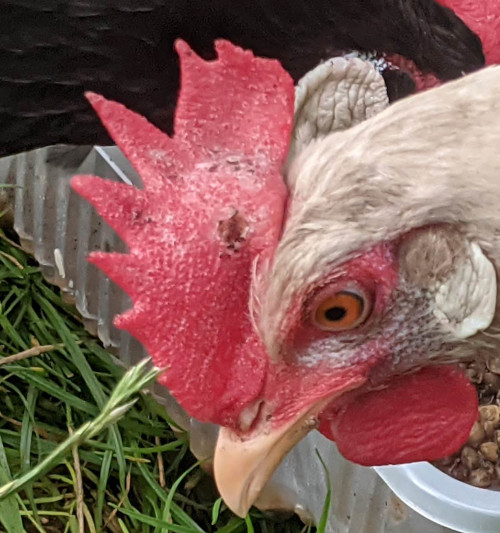
Injuries and insect bites tend to heal in a few days.
Droopy and floppy combs on chickens:
If you have a chicken with a normally upright comb and it has suddenly fallen over it may indicate the bird is unwell. Suddenly floppy combs can indicate dehydration or illness . Droopy combs also happen in older chickens.
An otherwise healthy chicken that develops a floppy comb is unlikely to be ill. This scenario can happen when big combed birds start to moult and the comb shrinks a little and begins to droop.
I have also seen it in broody hens, they stop laying and the comb goes a little paler and droops over to one side.
Some chickens have large, naturally floppy combs which may take some time to fall over.
Below: This white leghorn hen has a naturally floppy comb and there is nothing wrong with her.
Blisters, lumps and swellings on the comb:
Blisters, lumps and swelling on the comb have many varied causes.
The key difference is that swelling deep in the tissues is likely to be caused by infectious disease and requires immediate attention while surface blisters can be treated with home remedies.
The most common are insect bites or stings, contact with plants like stinging nettles, thorns or poison ivy.
Below: An example of a surface blister on a cockerels face. This can be left to clear up on it's own.

Swelling around the eyes is normally associated with an infectious disease but a lump located elsewhere on the comb or wattles is probably a sting.
Below: This is an example of deep tissue swelling around the eye and sinuses that is the result of an infectious agent. This requires immediate veterinary care.
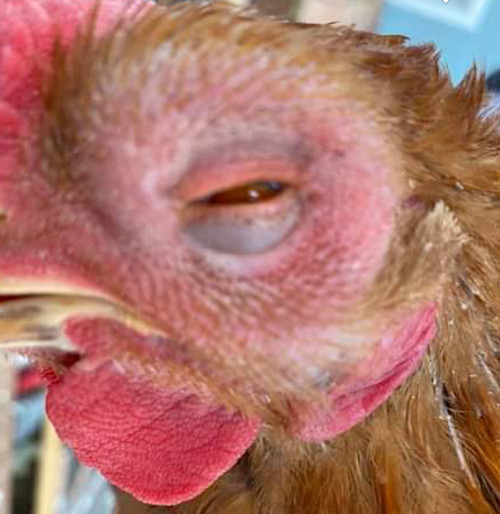
How to clean chickens comb:
To clean a chickens use water that has been boiled and cooled to 40 Celsius or 105 Fahrenheit. Wear disposable gloves and use cotton wool or other disposable and sterile cloth to wash the comb in the hand hot water.
You should not use any product that will sting if it gets into the chickens eyes.
A chickens eye has no tear duct to wash it, they rely on a nictitating membrane or third eyelid and soap or harmful chemicals can do much damage and cause blindness.
For the same reason you should not use salt in the water.
Why is the comb dry?
A chickens comb may be dry for a few reasons, a simple change in the weather, parasites or nutritional deficiencies.
You may know yourself as winter settles in you get chapped lips and dryer skin, the same is true for your hens. A little smear of Vaseline or coconut oil will sort the problem out in no time.
Parasites can give the appearance of dry skin, this can sometimes look like a dry waxy deposit in the ridges of the skin on the comb. Treat the coop and the birds and give a topical dressing of Vaseline or coconut oil to soothe the skin.
Below: Parasites can leave the comb looking dry with a waxy white deposit on the skin.

These sort of nutritional problems are common as chickens moult, the demand on the feed go up just as there is less time to eat, less insects and no greenery to eat.
Give some shelled sunflower seeds, a little extra protein and some fodder. Again give the comb a rub over with of Vaseline or coconut oil to ease any irritation.
Bleeding combs in chickens:
A chickens comb will bleed when it has been cut or injured, most often after fighting with another bird or catching it on a bit of sharp metal.
Below: A cockerel that has been fighting and is bleeding from the comb.
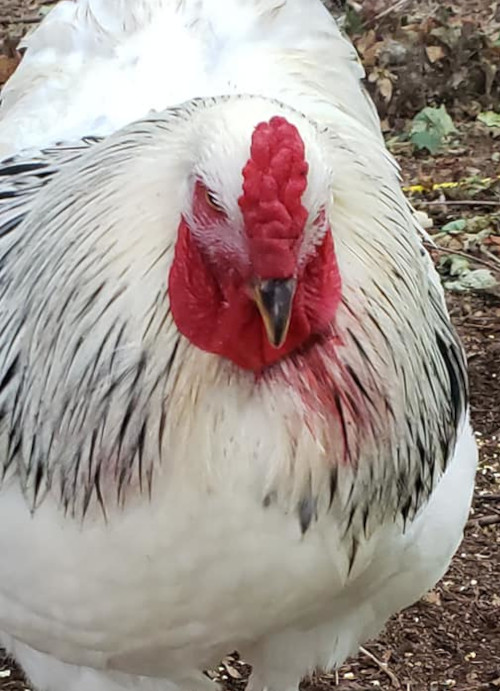
Clean the comb and the feathers with hand hot water and monitor for pecking or infection. You may need to separate them for a few days if the wounds are bad.
In my experience the comb tends to stop bleeding quickly, even quite severe injuries and amputations of parts of the comb and wattles heal quickly. If you have a comb that won't seem to stop bleeding hold a cold damp sterile cloth over the wound for a few minutes.
If a bit of the comb is hanging off you can remove it with a sharp pair of scissors but be careful not to make any injury worse.
